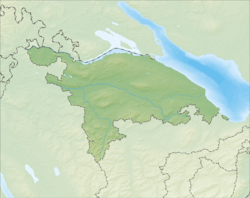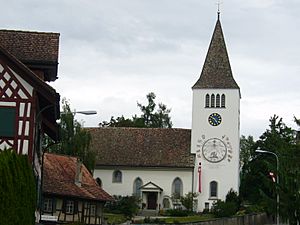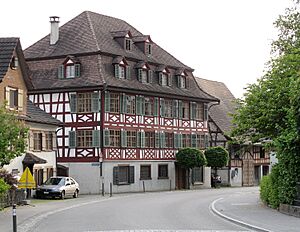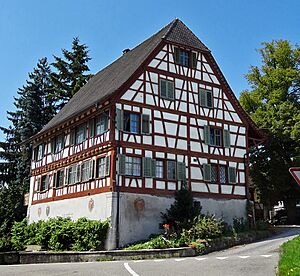Märstetten facts for kids
Quick facts for kids
Märstetten
|
||
|---|---|---|
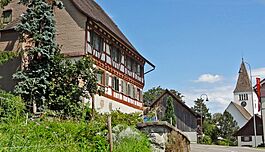 |
||
|
||
| Country | Switzerland | |
| Canton | Thurgau | |
| District | Weinfelden | |
| Area | ||
| • Total | 9.96 km2 (3.85 sq mi) | |
| Elevation | 425 m (1,394 ft) | |
| Population
(Dec 2020 )
|
||
| • Total | 2,896 | |
| • Density | 290.76/km2 (753.1/sq mi) | |
| Postal code |
8560
|
|
| Surrounded by | Amlikon-Bissegg, Kemmental, Weinfelden, Wigoltingen | |
Märstetten is a municipality (which is like a town or small district) in Switzerland. It's located in the Thurgau canton, which is one of Switzerland's states. Märstetten is part of the Weinfelden area.
Contents
Märstetten's Long History
Märstetten has been a home for people for a very long time! We know this from old discoveries like tools from the Neolithic (New Stone Age) and buildings from the time of the Romans. There are also graves from the Early Middle Ages, showing people lived here continuously.
From Barons to Families
In the High Middle Ages, a powerful Baron of Märstetten had a castle. The town itself was first mentioned in 1155. Back then, it was called Marsteten. The Cathedral of Constance gave it as a fief (a piece of land given in exchange for loyalty) to a noble family called von Klingen.
Over the years, the ownership of Märstetten changed hands many times. Different families, like the Muntprat, Breitenlandenberg, and Brümsi families, owned the land. In 1585, Leonhart Zollikofer's family took over and kept it until 1798.
The Church and Its Story
The Church of St. Jakob was once the Baron's private church. After 1155, it became part of the lands belonging to the Cathedral of Constance. In 1465, the church became independent from its main parish.
In 1482, Pope Sixtus IV gave the village special permission to hire its own priest. The Protestant Reformation (a big change in Christianity) came to Märstetten in 1529. However, the traditional Catholic Mass was still allowed for many years.
Community Gatherings
Starting in 1860, the people of Märstetten would gather every year on January 13th, which is St. Hilary's day. They would hold important meetings for the town and schools. After the meetings, they would share a special meal called the Hilärimahl.
Where is Märstetten?
Märstetten covers an area of about 9.97 square kilometers (3.85 square miles). A large part of this land, about 67.5%, is used for farming. Forests cover almost 20% of the area. The rest of the land is used for buildings, roads, or includes rivers and lakes.
Most of the built-up areas are industrial buildings, homes, and roads. The forests are mostly dense woods, with some smaller groups of trees. Farmers grow crops on most of the agricultural land.
Märstetten is located in the Weinfelden district, near the Ottenberg mountain. It's an important spot because it sits where two main roads meet: the one from Zürich to Romanshorn and the one from Wil to Constance. The municipality includes the main village of Märstetten, which is a haufendorf (an unplanned village with closely packed buildings). It also includes smaller areas called hamlets like Boltshausen, Altenburg, Dattenhub, and Ruberbaum, along with the former village of Ottoberg.
Who Lives in Märstetten?
Märstetten has a population of about 2,431 people (as of 2022). A small part of the population, about 10.6%, are people from other countries. Most people in Märstetten speak German, which is 94.8% of the population. The next most common languages are Albanian and Italian.
Age Groups in Märstetten
In Märstetten, you'll find people of all ages!
- About 11% of the population are children aged 0 to 9 years old.
- Around 15.7% are teenagers between 10 and 19 years old.
- Adults aged 20 to 59 make up about 57% of the population.
- People aged 60 and older make up about 16.9% of the population.
Homes and Families
In 2000, there were 862 private homes in Märstetten, with about 2.6 people living in each home on average. Most of the buildings were single-family homes. Many people lived in families with children, while others were couples without children or single parents.
Important Buildings and Sites
Märstetten has some very special buildings that are considered important Swiss heritage sites. These include the Hohes Haus and the Church of St. Jakob. The villages of Märstetten and Ottoberg, the hamlet of Boltshausen, and the Ottenberg Südhang area are also recognized for their historical value.
The Hohes Haus
The Hohes Haus (which means "High House") is a beautiful building made with a special type of construction called half-timbered. It was built in 1613 by Salomon Buchhorner from the Cathedral of Constance. It was originally used as a tithe barn, a place where farmers stored a portion of their crops as a tax. A courtroom was added in 1620. The inside of the building has amazing decorations and carvings from the late Renaissance period. The building was carefully restored in 1972.
The Church of St. Jakob
The Church of St. Jakob was first mentioned in 1155. Its bell tower and choir (the part of the church where the singers sit) were likely built in the 13th or 14th century. The church was made larger in 1465 and a sacristy (a room for the priest's robes and church items) was added in 1489. This gave the church its current look.
Inside the church, you can see a baptismal font from 1590 and a pulpit (where the sermon is given) from 1790. There's also a sundial painted on the outside in 1808. During a renovation in 1975, two old paintings called frescos were found. One shows the Christmas Story from the 15th century, and the other is a Last Judgement scene from around 1460–70.
Today, the Church of St. Jakob is shared by both Reformed (Protestant) and Roman Catholic Christians.
Märstetten's Economy
Märstetten has a healthy economy. In 2005, there were 124 people working in the primary economic sector, which includes farming and forestry. The secondary sector, which involves manufacturing and construction, employed 307 people. The largest number of people, 450, worked in the tertiary sector, which includes services like shops, offices, and healthcare.
Many people who live in Märstetten also work outside the municipality. However, many people also travel into Märstetten for work. Most people use a private car to get to work, while a smaller number use public transportation.
Religion in Märstetten
According to a 2000 survey, the main religions in Märstetten are:
- Swiss Reformed Church: About 55.8% of the population.
- Roman Catholic: About 25.6% of the population.
There are also smaller numbers of people who belong to other Christian churches, the Orthodox Church, and Islam. Some people do not belong to any church.
Education in Märstetten
Märstetten has its own primary school district. Many adults in Märstetten have completed higher education, either at a university or a specialized college.
In the 2008/2009 school year, there were 190 students in the primary school district. This included children in kindergarten and those in lower and upper primary levels. The average class size in primary school was about 18 or 19 students.
Transportation
Märstetten railway station is an important stop for trains that connect Märstetten to other towns. It is part of the Zürich S-Bahn network, with services S24 and S30 stopping there.
Images for kids
See also
 In Spanish: Märstetten para niños
In Spanish: Märstetten para niños




